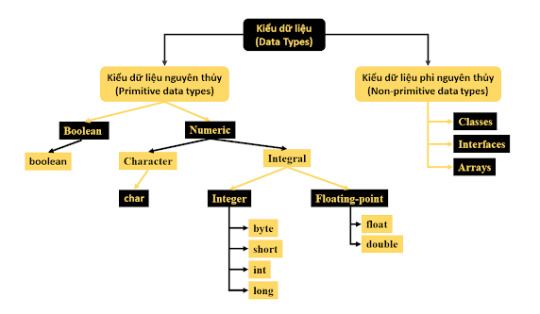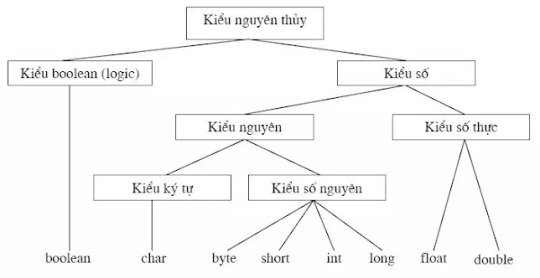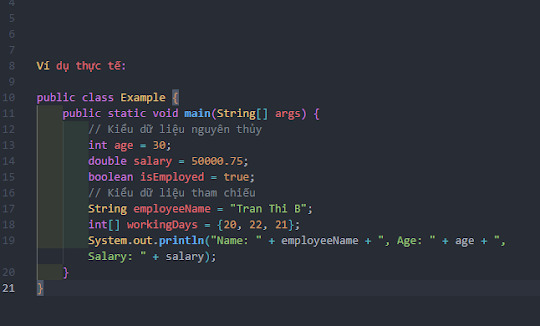#PrimitiveTypes
Explore tagged Tumblr posts
Text
Kiểu Dữ Liệu Trong Java - Phân Loại & Ví Dụ
Kiểu dữ liệu trong Java là một khái niệm nền tảng mà bất kỳ lập trình viên nào cũng cần nắm vững khi học và làm việc với ngôn ngữ lập trình Java. Kiểu dữ liệu xác định loại giá trị mà một biến có thể lưu trữ, cách nó được lưu trữ trong bộ nhớ và các thao tác có thể thực hiện trên biến đó. Trong bài viết này, chúng ta sẽ tìm hiểu chi tiết về các loại kiểu dữ liệu trong Java, cách phân loại chúng, ví dụ minh họa cụ thể.
Kiểu Dữ Liệu Trong Java Là Gì?
Kiểu dữ liệu trong Java là tập hợp các quy tắc xác định loại giá trị mà một biến có thể chứa, chẳng hạn như số nguyên, số thực, chuỗi ký tự hay các đối tượng phức tạp. Java là một ngôn ngữ lập trình hướng đối tượng và có tính kiểm tra kiểu dữ liệu chặt chẽ (strongly typed), nghĩa là bạn phải khai báo rõ ràng kiểu dữ liệu của biến trước khi sử dụng.
Java chia kiểu dữ liệu thành hai loại chính:
Kiểu dữ liệu nguyên thủy (Primitive Data Types): Các kiểu dữ liệu cơ bản, không phải đối tượng.
Kiểu dữ liệu tham chiếu (Reference Data Types): Các kiểu dữ liệu phức tạp hơn, chẳng hạn như đối tượng hoặc mảng.

Ảnh mô tả hệ thống các kiểu dữ liệu trong Java
1. Kiểu Dữ Liệu Nguyên Thủy (Primitive Data Types)
Kiểu dữ liệu nguyên thủy là các kiểu dữ liệu cơ bản được định nghĩa sẵn trong Java. Chúng không phải là đối tượng và lưu trữ trực tiếp giá trị trong bộ nhớ. Có 8 kiểu dữ liệu nguyên thủy trong Java, bao gồm:
1.1. Kiểu số nguyên (Integer Types)
byte: Kích thước 1 byte, lưu trữ số nguyên từ -128 đến 127.
short: Kích thước 2 byte, lưu trữ số nguyên từ -32,768 đến 32,767.
int: Kích thước 4 byte, lưu trữ số nguyên từ -2^31 đến 2^31-1.
long: Kích thước 8 byte, lưu trữ số nguyên từ -2^63 đến 2^63-1.
Ví dụ:
int age = 25;
long population = 8000000000L;
1.2. Kiểu số thực (Floating-Point Types)
float: Kích thước 4 byte, lưu trữ số thực với độ chính xác đơn.
double: Kích thước 8 byte, lưu trữ số thực với độ chính xác kép.
Ví dụ:
double pi = 3.14159;
float temperature = 36.6f;
1.3. Kiểu ký tự (Character Type)
char: Kích thước 2 byte, lưu trữ một ký tự Unicode.
Ví dụ: char letter = 'A';
1.4. Kiểu logic (Boolean Type)
boolean: Lưu trữ hai giá trị true hoặc false.
Ví dụ: boolean is Student = true;

Bảng tóm tắt kiểu dữ liệu nguyên thủy
2. Kiểu Dữ Liệu Tham Chiếu (Reference Data Types)
Kiểu dữ liệu tham chiếu lưu trữ tham chiếu (địa chỉ) đến dữ liệu thay vì giá trị thực tế. Các kiểu này bao gồm:
Lớp (Class): Các đối tượng được tạo từ lớp, chẳng hạn như String, Scanner.
Giao diện (Interface): Các giao diện như List, Map.
Mảng (Array): Tập hợp các phần tử cùng kiểu dữ liệu.
Chuỗi (String): Một kiểu đặc biệt dùng để lưu trữ chuỗi ký tự.
Ví dụ:
String name = "Nguyen Van A";
int[] numbers = {1, 2, 3, 4, 5};
Đặc điểm của kiểu dữ liệu tham chiếu:
Có thể là null (không tham chiếu đến đối tượng nào).
Được lưu trữ trong Heap Memory và quản lý bởi Garbage Collector.
Hỗ trợ các phương thức và thuộc tính của đối tượng.

Heap Memory và Stack Memory
Khi Nào Nên Sử Dụng Kiểu Dữ Liệu Nào?
Sử dụng kiểu dữ liệu nguyên thủy khi cần lưu trữ các giá trị đơn giản như số, ký tự hoặc giá trị logic để tối ưu hóa hiệu suất.
Sử dụng kiểu dữ liệu tham chiếu khi làm việc với các đối tượng phức tạp, chuỗi hoặc mảng.
Ví dụ thực tế:
public class Example {
public static void main(String[] args) {
// Kiểu dữ liệu nguyên thủy
int age = 30;
double salary = 50000.75;
boolean isEmployed = true;
// Kiểu dữ liệu tham chiếu
String employeeName = "Tran Thi B";
int[] workingDays = {20, 22, 21};
System.out.println("Name: " + employeeName + ", Age: " + age + ", Salary: " + salary);
}
}

Mã nguồn ví dụ
Mẹo Tối Ưu Khi Làm Việc Với Kiểu Dữ Liệu Trong Java
Chọn kiểu dữ liệu phù hợp: Sử dụng byte hoặc short thay cho int nếu giá trị nhỏ để tiết kiệm bộ nhớ.
Hiểu rõ phạm vi giá trị: Tránh lỗi tràn số (overflow) khi làm việc với int hoặc long.
Sử dụng StringBuilder cho chuỗi lớn: Thay vì dùng String để nối chuỗi nhiều lần.
Kiểm tra null: Với kiểu dữ liệu tham chiếu, luôn kiểm tra giá trị null để tránh lỗi NullPointerException.
Kết Luận
Hiểu rõ kiểu dữ liệu trong Java là bước đầu tiên để viết mã hiệu quả và tránh lỗi không mong muốn. Kiểu dữ liệu nguyên thủy phù hợp với các giá trị đơn giản, trong khi kiểu dữ liệu tham chiếu cần thiết cho các đối tượng phức tạp. Hy vọng bài viết này đã cung cấp cho bạn cái nhìn tổng quan và những ví dụ thực tế để áp dụng trong lập trình Java.
Nếu bạn muốn tìm hiểu sâu hơn về kiểu dữ liệu hoặc các chủ đề khác trong Java, hãy để lại câu hỏi hoặc theo dõi các bài viết tiếp theo của chúng tôi!
Kiểu Dữ Liệu Trong Java – Phân Loại & Ví Dụ Dễ Hiểu Tìm hiểu các kiểu dữ liệu cơ bản và tham chiếu trong Java. Bao gồm ví dụ minh hoạ rõ ràng giúp bạn học nhanh và nhớ lâu! 🌍 Website: Java Highlight
#Kiểu Dữ Liệu Trong Java#JavaHighlight#KieuDuLieuJava#JavaDataTypes#JavaBasics#LapTrinhJava#Javalearning#JavaTutorial#PrimitiveTypes#ReferenceTypes#JavaTips#CodeJava
0 notes
Link
The arrival of Unreal Engine 5.4 has sent ripples through the gaming community, particularly for developers seeking to push the boundaries of visual fidelity. While the engine boasts numerous improvements, a key area of focus is performance optimization. This translates to smoother gameplay experiences with potentially higher frame rates and more intricate graphical details. As a result, the evolution of ray tracing in Unreal Engine 5.4, compared to its predecessor, has garnered significant interest. Dissecting the Differences: A Video Comparison YouTuber JSFILMZ has emerged as a valuable resource for dissecting the nuances between Unreal Engine 5.3 and 5.4. Through a meticulously crafted video, JSFILMZ showcases the contrasting ray tracing capabilities of both versions. The video employs a controlled environment – the same scene with identical settings – to isolate the impact of the engine upgrades. Here, JSFILMZ utilizes a hardware-accelerated scenario to highlight the differences. Unreal Engine 5.4 Screen Space Reflections vs. Ray-Traced Reflections: A Trade-Off The video delves into the impact of Screen Space Reflections (SSR), a common rendering technique, within Unreal Engine 5.4. Compared to the previous version, JSFILMZ observes a noticeable decline in the quality of reflections, particularly evident in puddles within the scene. This observation suggests a potential shift in Unreal Engine 5.4's approach to ray tracing. The Performance vs. Fidelity Debate: A Calculated Decision While the diminished quality of reflections might raise eyebrows, it's crucial to consider the context. The observed trade-off likely stems from Epic Games' prioritization of performance in Unreal Engine 5.4. This optimization could translate to the ability to achieve higher frame rates or render more complex scenes without sacrificing smoothness. This becomes particularly important for developers targeting a wider audience, where high-end hardware may not be universally accessible. Beyond Reflections: A Holistic View of Ray Tracing It's important to remember that JSFILMZ's video focuses on a specific aspect of ray tracing – reflections. Unreal Engine 5.4 boasts a wider range of ray tracing improvements. These may include: Hardware Ray Tracing (HWRT) Optimizations: Enhancements to HWRT could lead to faster rendering times and potentially allow for more extensive use of ray tracing effects within a scene. Improved Path Tracer: The path tracer, a physically accurate lighting simulation tool, may benefit from optimizations, leading to more realistic lighting and shadow rendering. Additional Primitive Types: The inclusion of new primitive types within the engine could streamline the ray tracing process for specific objects, potentially improving efficiency. The Verdict: A Calculated Evolution for a Broader Gaming Experience Unreal Engine 5.4's approach to ray tracing signifies a calculated evolution. While certain aspects, like screen space reflections, might exhibit reduced fidelity, the overall goal seems to be to enhance performance for a wider range of hardware capabilities. This could open the door for a broader audience to experience the visual splendor of ray-traced games, with smoother frame rates even in demanding environments. FAQs Q: Does Unreal Engine 5.4 offer worse ray tracing than 5.3? A: Not necessarily. While JSFILMZ's video highlights a potential decline in screen space reflections, it's a single aspect. Unreal Engine 5.4 may offer optimizations in other ray tracing areas, potentially leading to a more balanced experience. Q: Why might Unreal Engine 5.4 prioritize performance? A: By optimizing performance, Unreal Engine 5.4 becomes accessible to a wider range of hardware, potentially allowing more gamers to experience ray-traced visuals. Q: Should I upgrade to Unreal Engine 5.4 for my game development project? A: The decision depends on your project's specific needs. If prioritizing cutting-edge ray tracing fidelity is paramount, you might want to consider both versions. However, if performance is a key concern, Unreal Engine 5.4 could be a valuable choice.
#framerates#gamingperformance#hardwareacceleratedrendering#JSFILMZ#pathtracer#performanceoptimization#primitivetypes#raytracing#screenspacereflections#UnrealEngine5.3#UnrealEngine5.4
0 notes
Video
youtube
This video is all about reflection. We're going to be adding the ability to support typing in Unity Shell so that automatic type conversion can occur. What does this mean? As a user of unity shell this will allow you to say "Cylinder" or "Sphere" and have those strings automatically converted to PrimitiveTypes if the Command expects them. The implementation of this uses a lot of reflection. It's a lot of trial and error and a lot of back and forth to get this working. I've never done anything like this before. It's not as complex as I made it. The project is open source on GitHub. Check it out for yourself or even contribute back here: http://ift.tt/2u0uSVo Discord: http://ift.tt/2txCKO8 Image Credit: The thumbnail for this video uses Creative Commons licensed images. http://ift.tt/2vmy1BY
0 notes